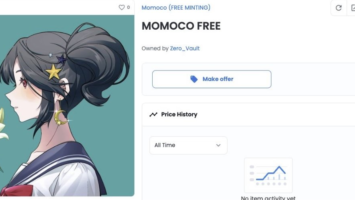Fundamentally, Ledger is a hardware wallet that’s quickly becoming the go-to wallet for Web3 enthusiasts. Since its inception in 2014, Ledger has been at the forefront of promoting security in both the crypto and emerging Web3 spaces.

Credit: Financial Times
Since Ledger brought Ian Rogers onboard just one year and four months ago, the company has put a greater emphasis on user experience. In addition, Ledger is also working hard to teach both crypto enthusiasts as well as crypto-curious individuals how important it is to secure your assets in Web3.
To learn more about Ledger’s vision in terms of user experience and education, NFTevening interviewed Ian Rodgers, the company’s Chief Experience Officer. Ian was kind enough to let us interview him at the Ledger Villa in Lisbon. What followed was an interesting narrative of how he made the transition from the music industry to the crypto and NFT space, and why security is crucial in Web3.
This interview was conducted by NFTevening’s Janelle Borg. Quotes are condensed and edited for clarity.
The early days of the internet
Ian is, first and foremost, a music fanatic. Therefore, it comes as no surprise that his first encounter with internet culture was primarily due to music. “I’ve been collecting records since I was five years old and programming computers since I was eight years old. What the internet meant for me was a way to share culture with people,” he said.
The internet in its heyday was full of music nerds, academics and tech enthusiasts excited to learn more about the emerging technology. Ian notes that the same sense of enthusiasm is shared by crypto and NFT enthusiasts today.
“The Internet was this big unlock for culture. Because, you know, it got around borders, it got around record labels. It got this new thing going, and that’s what I dedicated the early part of my career to.”
From the music industry to crypto and Ledger
Ian’s passion paid off. After graduating with a Bachelor of Arts in Computer Science from Indiana University in 1994, he became deeply involved in the intersection of music and technology. He built some of the earliest music-related websites and worked in the digital music industry for more than twenty years. In fact, he played a vital role in the 2015 launch of Apple Music, including Beats 1, their digital streaming channel.
After calling it a day at Apple, he transferred his experience to the luxury goods industry. He worked with the esteemed brand LVMH Moët Hennessy Louis Vuitton, commonly known as LVMH, as the Chief Digital Officer. It was around this time that the crypto space piqued his interest.
“I became personally invested in crypto around 2015, because [of] the ethics of, you know, decentralization and honestly, just convenience on some level. You try to transfer $100,000 from one bank account to another, not so easy. Send $100,000 from one person to another, using crypto. Really easy.”
Ian became particularly interested in the way the crypto and NFT space was forming its own communities. In fact, Ian likened this to a passport, which tells each of us which nation-state we belong to. Therefore, being part of an NFT community is also an identity marker. It is also a way to meet like-minded people who share the same interests.

Credit: D. Carvalho
The evolution of user experience in crypto
“If you look at digital music, you know, it’s a really interesting study, because we knew that digital music would be the future in 1993. Certainly, by 1998, it was clear,” Rogers points out.
“So now look, acknowledging crypto through the same lens, we have kind of roughly the same amount of people in crypto as we had on the internet in 1998, or 99. And crypto or digital assets being the future is very obvious. Even though there are still many deniers, it smells very familiar.”
Ian was very involved in shaping the user experience of digital music. He noted that even when the user experience of digital music was very poor, there were still many people interested in learning more about it. Eventually, big companies started investing in digital music, leading to the $28.2 billion behemoth it is today.
“From my perspective, it’s not a question of if. It’s only a question of when, and where are we on that timeline? You know, how much different will it look in 10 years than it does today,” Rogers pondered. “And I think it will look as different as the internet did, you know, in 1998 with 56k, modems…and tonnes of promise and lots of excitement.”
“And so what you get over time is a lot of smart people, big companies, engineers, user experience designers, PhDs in computer-human interaction, who apply their talents to making this user experience better.” According to Ian, this aggregation of talent will bring Web3 and crypto to new heights in the years ahead.

Education as a tool for more educated Web3 natives
However, with new technology and greater freedom comes great responsibility. With the Ledger Academy and Live Sessions, Ledger is investing in educating people about crypto and what it means to control your assets. According to Ian, there is a fundamental new freedom that most people still know nothing about.
“There’s fundamental new freedom here, which is self custody. I can actually own my own digital assets. I don’t have to leave them in the control of someone else, and the control of a bank and the control of, you know, in the cloud of Google, in the cloud of Spotify, in the cloud of Netflix. No, I have my own custody.”
Ian notes that software wallets have only scaled much larger than Ledger because they are willing to compromise security. He states, “I think that what hasn’t changed at Ledger is that unwillingness to compromise on security, but what has changed is offering people that, you know, top-level of security with a better user experience.”
Ledger’s vision vis-a-vis user experience
Ledger’s recent collaborations with a wide variety of brands, ranging from The Sandbox to Fendi, show the company’s commitment to bringing security to everyone. This does not mean that Ledger is compromising on security. On the contrary, Ian insists Ledger is strengthening its core values of security and ease of use.
With Web3, Ledger understands that: “I want to connect to all kinds of places where I can utilize my digital assets and login with, you know, with the assets that I hold. Okay, well, I need to be able to do that easily and securely.”
“If I’m sending you an NFT, now we have that in Ledger Live where you can secure clear signing on an entity,” he said. Ian also noted that more people need to know what they’re signing up for. “So we really need to get blind signing to be something that is like unsafe sex. It’s fine. Yeah. Maybe even fun. Until it isn’t. And then it can be really devastating, right, can change your life.”
This is why Ledger advocates for more education when it comes to signing smart contracts. “We need to get people to know that they need top security, great ease of use, easy onboarding, easy connection to Web3 and clear signing. I really think that by the end of 2022, I’ll be able to say we [Ledger] have all of these things better than anyone on the planet. That’s what we’re working hard on.”
Are you tired of missing important NFT drops?
Just check out our NFT Calendar!
Receive the biggest NFT news of the day & recommendations in our Daily newsletter.
All investment/financial opinions expressed by NFTevening.com are not recommendations.
This article is educational material.
As always, make your own research prior to making any kind of investment.






















Comments (No)